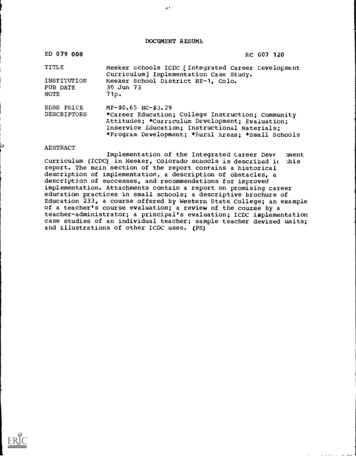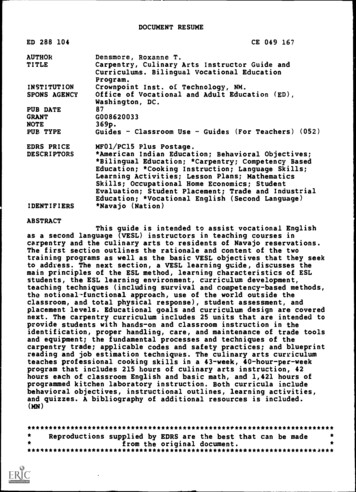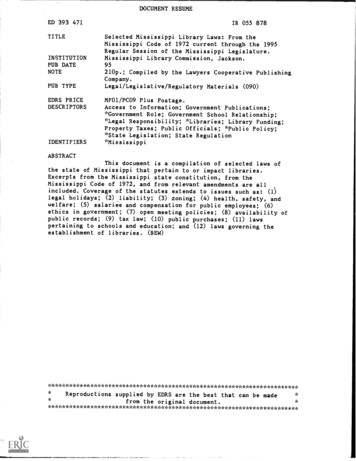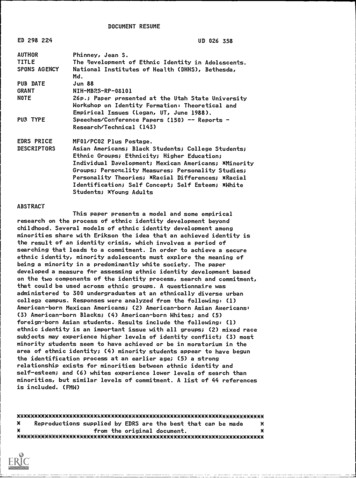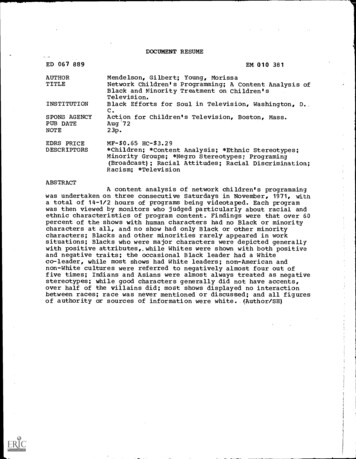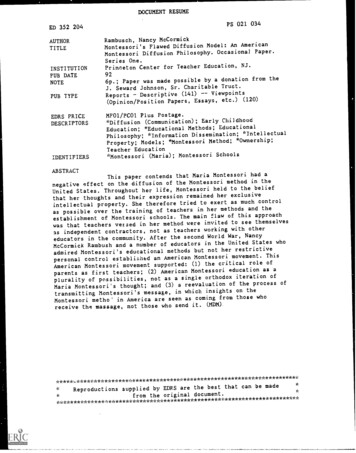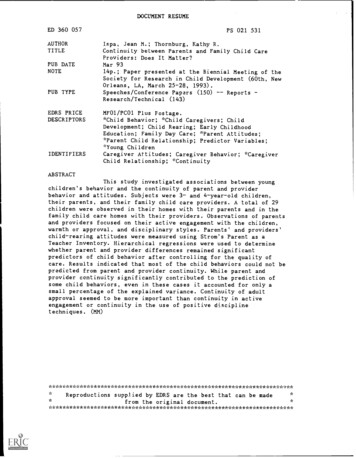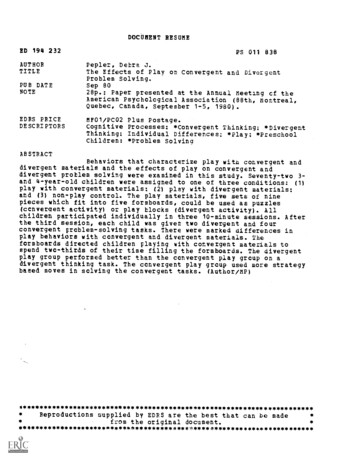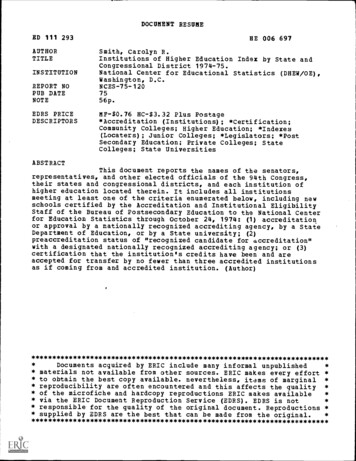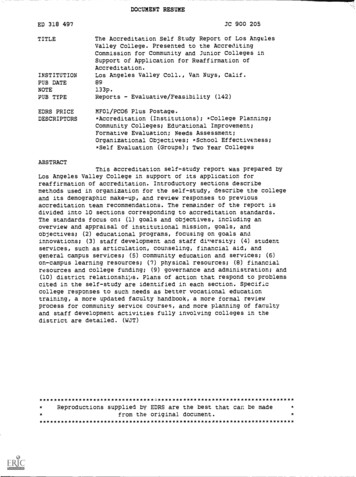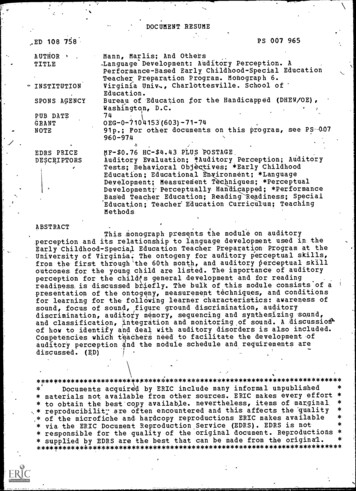
Transcription
DOCUMENT RESUMEPS 007 965.ED 108 758AUTHORTITLE- INSTITUTIONSPONS AGENCYPUB DATEGRANTNOTEMann, Marlis; And Others-Language Development: Auditory Perception. APerformance-Based Early Childhood-Special EducationSeacher Preparation Program. Monograph 6.Virginia- Univ., Charlottesville. School ofEducation.Bureau of Education for the Handicapped (DHEW/OE) ,Washington, D.C.740EG-0-004153(603)-71-7491p.; For other documents on this program, see PS-007960-974EDRS PRICEDESCRIPTORSMF- 0.76 HC- 4.43 PLUS POSTAGE.Auditory Perception; AuditoryAuditory Evaluation;Tests; Behavioral Obj tives; *Early Childhoodironment; *LanguageEducation; EducationalDevelopment; Measuredent T hniques; *PerceptualDevelopmentv Perceptually Han iapped; *Performance,Based Teacher Education; ReadingReadiness; SpecialEducation; Teachef Education Curriculum; TeachingMethodsABSTRACTThis Monograph presents the module on auditoryperception and its relationship to language development used in theEarly Childhood-Speciq. Education Teacher Preparation Program at theUniversity of Virginia: The ontogeny for auditory perceptual skills,from the first through'the 60th month, and auditory 15erceptual skilloutcomes for the young child are listed. The importance of auditoryperception for the childs general development and for readingreadiness. is discussed br4efly. The bulk of this module consists of apresentation of the ontogeny, measurement techniques, and conditionsfor learning for the following learner characteristics: awareness ofsound, focus of sound, ifigure ground discrimination, auditorydiscrimination, auditory memory, sequencing and synthesizing sound,and classification, integration and monitoringof sound. A discussiolP.of how to identify and deal with auditory disorders is also included.Competencies whioh tbachers need to facilitate the development ofauditory perception 4nd the module schedule and requirements arediscussed. **************************Documents acquired by ERIC include many informal unpublished** materials not available from other sources. ERIC makes every effort ** to obtain the best copy available. nevertheless, items of marginal *reproducibilit: are often encountered and this affects the quality *** of the microfiche and hardcopy reproductions ERIC makes available** via the ERIC Document Reproduction, Service (EDRS). EDRS is not* responsible for the quality of the original document. Reproductions ** supplied by EDRS are the best that can be made from the ******************************
U S DEPARTMENT OF HEALTH,EDUCATION& WELFARENATIONAL INSTITUTE OFEDUC4TIDNTHIS DOCUMENT HAS BEEN REPROOUCED EXACTLY AS RECEIVED FROMationTHE PERSON OR ORGANIZATION ORIGINATING IT POINTS OF VIEW OR OPINIONSSTATED 00 NOT NECESSARILY RERRE.SENT OFFICIAL-NATIONAL INSTITUTE OFEDUCATION POSITION OR POLICYOE) ,PS 0 07itoryalmanceeciaiingn theat thekills,skillitoryis of aitionsess ofIozund,cussioficluded.ofreLanguage Development:Auditory Perception*********shed*effort *rginal *uality **lableMarlin MannStan CookeKathy Young*ofMonograph VIuctions *inal.**********o-o,i-o 2
tile development of the prograin reported herein was supported by the Bureau ofEducation for the Handicapped of the U.S. Office of Education (0EG-0-710415316031) 1971-1974.Thdopinions expressed hdrein do not necessarily reflect the position or policy ofthe Bureau of Education for the Handicapped and no official endorsement-by BEHshould be inferred./Printed byJefferson Printing,215 Albemarle St.Charlottesville, VirginiaforJA PerforMance-Based Early Childhood-Special EducationTeacher Preparation Programat theSchool of EducationUniversity of VirginiaCharlottesville, VirginiaAll Photographs except Back Cover:Lovelace CookBACK COVE,R: Ruffner Hall, School of Education, University of Virginia.(Courtesy of University of Virginia Department of Graphics.,.
TABLE OF CONTENTSPreface1Introduction-Ontogeny for Auditory Perceptual Skills,5Auditory Perceptual Skill Outcomes9Relevancy of Auditory Perceptionof Auditory Perception to ReadingLearner CharacteristicsAwareness of SoundOntogeny11131721.0AeasurementConditions-for Learning .Focus of Sound29OntogenyMeasurement7Conditions for, Learning.,.Figure Ground Discrimination3133Ontog'enyMeasurementConditions for LearningAuditory Discrimination3435OntogenyMeasurement36Conditions for Learning;39Auditory. Memory52-OntogenyMeasurement-Conditions for Learning55
Sequencing acid Synthesizing Sound571--OntogenyMeasurementConditions for Learningr6-3Classification, Integration-and Monitoringof Sound70OntogenyMeasurementCoriditiOns for LearningCompetencies Teacher Need to TacilitateDevelopment ofAuditory PerceptionCognitive Competencies'Skill CompetenciesModule Schedule and RequirementstOOOOOOOOO 6Requited Readings for Auditoryjerception.,ReferencesO83OOO870 fl 0' 5
(PREFACEGraduate students providing lesson plan ideas for this moduleinclude Gail Prillan, Lori Bevan, Mary Whitesell, Helen Musey,Jane Griffith, Susan O'Donnell,., Mary Tankersley, Virginia Raudell,and Lynne Mnnn.1if0 0 6.
INTRODUCTIONThe auditory receptive channel is undoubtedly one of the mostimportant avenues through wlich children recieve information abouttheir physical and social environment. From the very beginning,children live immersed in a world of sound--a world of auditorystimulation that constitutes a basiC foundation for learning,If Children are to grow and develop approgrowing and living.priately--that is, if they are to become happy and productivelearners, capable of experiencing a full measure of the joysof thier universe and able to cope effectively with the demandsof their social environment--they must acquire adequate auditoryNormal emotional,-13-n-dial, intellectual andreceptive skills.academic development requires that children be able to detect,perceive, understand and retain a vast amount of auditory information., The ramifications of inadequate auditory receptivefunctioning may prove disastrous for many children. The wellbeing, the futures and, perhaps, the very survival of some children may be at stake. (Farrald and Schamber, 1973, p. 124).23
.ONTOGENY'FOR AUDITORY PERCEPTUAL SKILLS1monthsa. Quieted by-voice (Griffiths, 1954)b. Activity diminished when approached bysound. (Gessell, 195)Responds to high pitch more than low pitch2monthsAttends tcL human voice (oricents head to sound11th-, week)Stdrteled response to noise.Shows pleasure at musical sounds3monthsa. Looks at speaker's face (Gessell, 1956)b. Anticipates feeding by noises and visualstimulic. Listens to music box, w&toh ticking.4monthsTurns.head deiliberately to voice and willsearch fot source of Voice. (Cattell, 1950;Griggiths, 1954)monthsa. Distinguishes between friendly and angrytalking.b. Demonstrates interest in human. voice (Hardy\1962)Reacts to musid by cooing.d. Enjoys sounds of crumbling paper andother actions of his own.c.7-8months9-10-months'a. Responds when called (Griffiths, 1954)b. Raises arms when mother says "Come up" andreaches toward child. (D'Asaro &John, 1958)(D'Asaroc. Looks at daddy when daddy is named& John, 1958)a. Activity stops when he hears "no -rib" or hisname. (Gesell. 1956)b. Re'spond's to verbal requests like "bye-bye"c. Not distracted much by various env.ironmental/sounds outside immediate test situation.(Hardy,.1962)d. Listens with interest to. words.11-12 monthsa. Likes to listen to words.b. Interest begins in environmental -noise intest situation. (Hardy, 1962.)c. Givea toll on request when accompanied- b -vgesture (Gesell. 1950Adjusts to simple-verbal suggestions.13-14- monthsa. Knows own name. -(Griffiths, 195'4)h. Likes rhymes and jingles (Griffiths, 1954)c. Distinguishes between phonemes of naturelanguage. (Ervin & Tripp)
monthan box identified when nameOne objecta.(Griffiths, 1954)b.Finds "baby" in picture when askedc.Recognl zes hair, mouth, ears, and handswhen they are named (Mecham, 1959).(D' -Asaro & John, 1958).17 -18 monthsRespond& to simple command as -"put ballin the chair." (Hood & Allendes, 1960) nTwo objects in box identified. (Griffiths,.-1950Enjoys picture book.d., Listens to rhymes and songs forc.19-20 monthsminutes.a.Can identify 4 objects in box. (Griffiths,b.Points to any 3 parts of a doll. (Hood--&Allendes, 1960)Follows one-level-spoken commands. (Hood &Allendes, 1960)1954),c.ti21-22 months.a.Points to 4 or 5 Tarts of a doll: (Mitten.,b.Mill follow a short series of related'com-1950)-mends.23-24 monthsa.b.Carries,out 4 directions with ball. (Gessell& Ametruder, 1956)/Likes to listen, to reason of language, notjust sound, (Griffiths 1954)Listens to simp1e stories, showing preferencefor those he has heard before',c,,25th montha.Understands two prepositions.2-7th month'a,Identifies at.least six of the followingpictures from names: dog, aup, shoe, house,flag, star, leaf, basket, book.28th monthaUnderstands three prepositions.30th month. a.36th montha.b.Identifies pictures from' name: (at leastseven of 'the following: dog, cup, shoe,ihouse, flag, clock star, leaf, bas ket,book.Learns to listen-and listens to learn.:(Single word spoken by mothei may in&tan'taneously reorganize whole Stream-of ACtiVitY,)Suggestions take effect.0, (9
c.cr.Memory span lengthening - recalls events ofyesterday.Beginning to distinguish between black andwhite.e.f.,,g.h.i.48th montha.b.60th montha.b.c.Generalization common in comirehensionin, on under.Distinguishes one and many,Listens and can be reasoned with verbally.Listens -to longer-and-more varied stories.Answer -s simple questions,,Tends to re-enact in body postures andgestures what is told in a story.Comprehends: what do you do when hungry,,thirsty, or tired.Can single out one word and ask its meaningwhere as formerly reacted to sentence asa whole.Genuine interchange of ideas remains- limited,Tries to use new words, can define some'simple words.d.The above ontogenyNo. 6, June 1964,onai&erable time- lOOking at boOka - likesUnderstands aome--40tractte-be nee& to.wOrds, (connectives, colors)s an excerpt from The Volta Review,, Volume 67,41-7-419,,a
-AUDITORY PERCEPTUAL SKILL OUTCOMES1.Awareness of sound.To be able to determine was there asound.-4Focus of sound.To be able to determine where was the sound.,(a)(b),- To be able to attend to- sound.Figure- ground discrimination. To be able to determine3,J.,/here was more than ''one sound.Auditory diicriminatton.To be able to determide if-the sounds were the(a)same or nit the same.To identify rhyming.words(b)To distinguish the sound6 of the various phondmes.(c)To identify the sounds of the various phonomes.(d)To-disciminate'degree of sound. To be able( -e)to- identify loud and soft sounds.Auditorymemoty. Short and long term recall which5.To identify the sounds-tnvolVes several auditory skills.of -the various phonomes.S equencingland.sYnthesii-ing sound.6.2.-(a)',To 1)e able to- determine what ws6 the sequence -ofscsound6,-(b)-to be able to- determine- What Was the length oft3:metween sounds ,(ftrst, -next, last) .'Classification,.intsgration-and: monitaring 'of sound'.-What do the\sounds anti- words- mean?-(A)--(b)-(c)-(d)(e)To- distinguish and identify common- sounds in theenv I4mment.To associate meanIngs with-spoken-words.To obtain mesning from'seritence'structure.TO follow dimple explanations;- ,carryOut one--step direc -tions given orsily, then two-Step;directions, etc.To gair, an understanding of what to look and listenfor 6i1 sxperiencesl "tunelin" when directed to.\
RELEVANCY OF AUDITORY PERCEPTION.we live immersed in a world of sound.It is probablethat human beings spend more time in listening than inany other activity.ant-; yet ; .we do riotot knbw show an individual learns- to listen, how this function develops,or the ways in which it is- influenced by psychologicalvariables (Sabatim,' 1969, T. 730).Receptive language skillibegfrito develop before birth withthe development of the basic physiological equipment of audition andperception. The sequential refinement of auditory perception skillsbegins at birth with the simple awareness of sound, the realizationtha t sound- is 4ifferent than silence. By, one month'an infantattentds to and can be Wieted by a voice, rudimental integrationcf a sound with a Meaning.Next cotes the ability to fdcus on-a sound, to determine its point 61 origin, a 4,mOnth old child willeearcth for a sound.By 5 or 6 months the child can distinguishbqween stern or friendly Voices and react-accordingly another step*-in sound- meaning integration. 4t 7 or S months a baby will attendwhen called, evidence that he/she can iscriminate the sound o -f -his/y 9.orer'-name or the pitch of voice that means-to pay attention.10-months, the child will -cease activity at a-- "no -no" and beans tocomply with aiMple verbal Tequests. ,A childmust have deVelcipe& basicfigure -eround\dicrimination to perform these last aeveralskills.When'called,thf child must be able to tell that a-new sound bas- beenadded to the backginund hubbub and Otermine that it is-dominant.From this skill develops auditory discrimination, the ability toThe nextdiscern differences. in two aounds, heard simnitaneously.Then comesrefinement is discTimination of degree, volume, -and pitch,thAability to sequence and- Ayhthesize, to be aware of the component,1.-parts of a-complex sound-.Sy 15-1-6 months a toddler can identifybody-part6 when named -, new proof of developing ability. to Imeegrateor with words.and classify sounds and to associate meaning with them,t 17 - 18 months a child can obey simple commands and at 21-22-monthsllow several related commands.Most auditory perceptual skills are not developed to their po\\By twotentIV even in adults and certaily not in a two year old.the A: ,erage child has a basis for growth even at this age which willenabl the improvement of perception of sound to a level of competAr(cywhich ill allow him/her to communicate freel
(D' -Asaro & John, 1958). c. Recognl_zes hair, mouth, ears, and hands. when they are named (Mecham, 1959). Respond& to simple command as -"put ball. in the chair." (Hood & Allendes, 1960) n. Two objects in box identified. (Griffiths,-1950. c. Enjoys picture book. d., Listens to rhymes and songs for. minutes. a. Can identify 4 objects in box .
